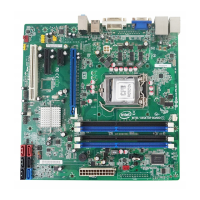
Do you have a question about the Intel DB65AL and is the answer not in the manual?
| Socket Type | LGA 1155 |
|---|---|
| Maximum RAM | 16 GB |
| Supported RAM Types | DDR3 |
| Memory Slots | 2 |
| Memory Standard | DDR3 1333/1066 |
| Storage Interface | 4 x SATA 3Gb/s |
| USB Ports | 8 x USB 2.0 (4 rear, 4 via headers) |
| Audio | Realtek ALC662 |
| LAN | Realtek RTL8111E Gigabit Ethernet |
| Graphics Output | VGA, DVI-D, HDMI |
| Power Connector | 24-pin ATX |
| Expansion Slots | 1 x PCI Express x16, 1 x PCI Express x1, 2 x PCI |
Provides a general summary of the Intel Desktop Board DB65AL features and specifications.
Lists the major features of the board including form factor, chipset, memory, and interfaces.
Illustrates the physical arrangement of major components on the Intel Desktop Board DB65AL.
Provides a functional overview of the board's major components and their interconnections.
Highlights specific changes and differences compared to other Intel Desktop Board products.
Lists Intel's website resources for finding board information, support, and drivers.
Details supported Intel processors for the LGA1155 socket and their TDP.
Describes the Intel B65 Platform Controller Hub (PCH) and its interfaces.
Details supported memory types, capacity, channels, and configurations.
Covers integrated graphics (VGA, DVI-D) and discrete graphics via PCI Express x16.
Details the number and arrangement of USB 2.0 ports on the board.
Describes the SATA connectors, their transfer rates, and modes.
Covers features like the serial port and PS/2 interface.
Details the Realtek ALC888S audio codec and its features.
Describes the Gigabit Ethernet controller and RJ-45 connector.
Explains the coin-cell battery powering the RTC and CMOS memory.
Shows locations of thermal sensors and fan headers for monitoring.
Covers system management functions and security features.
Explains Intel's technology for tamper-resistant system management.
Details hardware and software support for power management features.
Details addressable memory capacity and the system memory map.
Describes the board's connectors and headers, including protection features.
Explains the jumper block for configuring BIOS modes (normal, configure, recovery).
Discusses physical dimensions, form factor, and chassis compatibility.
Covers power supply requirements, current capabilities, and tolerances.
Addresses chassis airflow requirements and ambient temperature limits.
Introduces the Intel BIOS, its storage, and the setup program access.
Explains SMBIOS for managing system components and obtaining information.
Details support for USB devices before OS drivers are available.
Explains methods and utilities for updating the BIOS.
Explains procedures and media for recovering a damaged BIOS.
Covers user choices for booting from various devices like HDD, optical, network.
Covers supervisor and user passwords for BIOS setup and computer booting.
Lists BIOS beep code patterns and frequencies for error diagnosis during POST.
Lists front panel LED blink patterns for error messages during POST.
Provides descriptions for common BIOS error messages encountered during boot.
Explains POST codes generated to I/O port 80h for diagnostic purposes.
Details safety, EMC, and product certification compliance standards.
Provides information on product ecology, disposal, and recycling programs.
Lists EMC regulations the board complies with, including FCC and CE.
Covers compliance with energy efficiency and environmental standards.
Provides cautions and guidelines for battery replacement and proper disposal.
